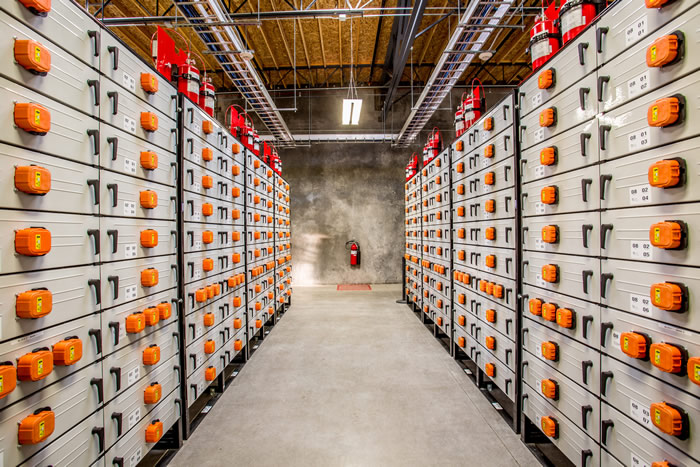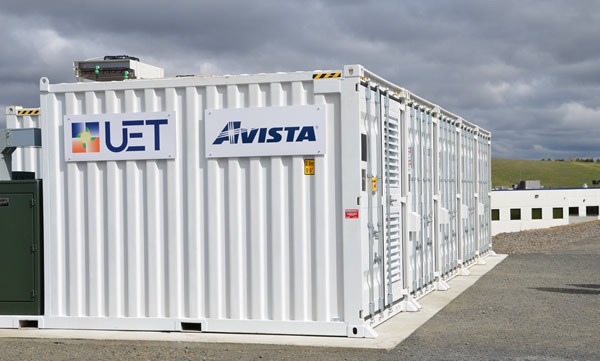
Portland General Electric Battery Storage CC
With a rapid decline of costs outpacing expectations, energy storage is following a positive trajectory similar to that of solar PV a decade ago. In fact in the past few years, battery costs have been declining much faster than solar costs did.
The decline in storage costs is driven by investments in the fast-growing electric vehicle industry, and as costs decrease, the rate of return on energy storage projects improves, attracting even more customers. It’s a virtuous cycle, as major manufacturers are ramping up lithium ion battery production to achieve economies of scale for EV markets, creating a battery glut, and putting further downward pressure on battery prices.
According to Bloomberg New Energy finance, as of the end of 2017, the average price of a lithium-ion battery pack was down to $209/kilowatt-hour and expected to fall below $100/kWh by 2025. Meanwhile the Energy Storage Association describes the growth of the global energy storage market as “exponential,” citing an annual installation of 6 gigawatts (GW) in 2017 and projecting over 40 GW per year by 2022.
Energy Storage: The Next Revolution in the Power Industry
The US energy storage market is growing quickly too, with the behind-the-meter storage market accounting for 55% of the total MW deployed at the end of 2017, according to the US Energy Storage Monitor from GTM Research and the Energy Storage Association.1 In general, more cost-effective batteries, continuing declines in inverter costs and improved efficiencies in system integration are lowering the overall hardware costs of storage systems. These trends are making energy storage an attractive new focus in the distributed energy marketplace, for both new and existing distributed energy projects.
Behind-the-meter opportunities to invest in solar-plus-storage systems are particularly attractive for commercial and industrial customers who may be paying steep electricity demand charges, which can make up over 50% of their energy bills. These are the unpredictable fees companies pay in addition to the cost of energy, and they are calculated to account for the maximum amount of power drawn from the grid at a given time period. The addition of a distributed energy project such as solar-plus-storage, and potentially combined heat and power (CHP) as well, can shave peaks as well as curbing overall energy demand, which will substantially reduce electricity bills for such customers.
Aside from demand charges, some customers in regions where utilities are implementing Time-of-Use (TOU) tariffs are starting to see reduced financial benefits from their solar investments. In these areas (such as California), customers are looking at storage to take even more control of their energy use. Time-of-Use rates create the need to meet peak electric loads during more expensive time periods when solar generation has fallen off, such as late afternoon and evening, and that requires storage.

Avista Utility in WA, Flow Batteries, CC
Getting the Most Out of Your Energy Storage Investment
Although energy storage is currently most attractive in areas where there are good incentives, there is growing recognition that storage will soon alter the entire energy landscape radically. Many states are conducting studies, funding pilot projects or considering new storage incentives.
So far the level of investment in energy storage is a clear response to policy mandates and economic incentives in the handful of states that account for most of the installed storage capacity in the US. California leads the way with 45.1 MW of commercial storage deployed as of Q4 2017, while New York is in second place with 1.8 MW, and all other states put together with 2.4 MW of storage deployed.
California initiated the move towards storage technology almost a decade ago, with pioneering legislation (AB 2541) that established storage mandates for the state’s largest utilities. Ultimately, the California Public Utilities Commission (CPUC) approved targets requiring California’s three largest investor-owned utilities (IOUs), aggregators, and other energy service providers to procure 1.3 gigawatts of energy storage by 2020; the CPUC recently added another 500 MW to that obligation.
That policy initiative, in addition to the determination of battery manufacturers to produce affordable batteries for electric cars, has driven California’s tsunami of investments in solar-plus-storage systems. That’s partly due to the leadership of Tesla CEO Elon Musk, who surprised investors by merging SolarCity and Tesla to create a new kind of energy company. Musk’s vision has always been to make affordable batteries for cars, buildings, and utilities.
Along with its storage mandate, California has provided generous incentives for storage investments through its Self-Generation Incentive Program (SGIP), which continues to grow. New York, Massachusetts, Oregon and Arizona are also in the process of either establishing storage targets or incentivizing investments in energy storage.
As the price of energy storage drops, the value propositions are also increasing rapidly. Many see storage as the crucial bridge between concerns about the variable nature of renewable energy and the promise of clean, reliable power that is available 24/7.
Energy storage gives rise to a wide variety of value streams including its previously mentioned demand charge reduction or peak-shaving capabilities and its time-shifting value with TOU rate structures. Storage can also provide valuable backup power and make mission-critical facilities more resilient. It can help utilities integrate more renewable energy by balancing variations in power supply and providing additional capacity when needed, as it replaces natural gas “peaker” plants. One immediately apparent value is that storage technology is allowing utilities to defer – or even replace – expensive upgrades in transmission and distribution. Last but not least, storage is set to open up new opportunities for wholesale trading of power resources.
Challenges in Sizing and Designing Storage Systems
While it’s encouraging that energy storage equipment costs are declining rapidly, the financial advisory firm Lazard reports in a December 2017 analysis 2 that some of these price declines are being offset by increased engineering costs. That creates opportunities for competition in design and engineering of new storage or hybrid systems.
Solar developers and EPCs working in states where there is a nascent storage industry report that there are intense efforts to reduce these soft costs of hybrid distributed energy projects, and one of the most important costs is system design.
Designing hybrid energy systems – that is to say systems with multiple components such as solar, energy storage, and CHP – is inherently complex. The various values that storage provides make the problem more complex because the financial benefits accrue to different parties. And, there are sometimes critical tradeoffs. A system optimally designed for a commercial utility customer seeking to reduce demand charges might not require the same component sizing as a system designed to provide reliable backup, or firmed capacity. Operating a system to capture both values mean sacrificing at least some of each value.
Determining which customers might benefit from storage investments and in what configuration is thus a complicated process ideally requiring detailed customer load data (prior electricity use at 15 minute intervals, which is not widely available until smart meter distribution is widespread), access to current utility tariffs, and finally, comprehension of the economics of energy storage. Then different system configurations must be examined or modeled in the context of these variables.
HOMER Grid Determines Financially Optimal System Configurations
 To respond to this challenge, HOMER Energy has developed a new software product: HOMER Grid is intended to simplify the process of designing hybrid systems that include storage, and thus lower the overall project cost. The new software is built on the HOMER engine, a proven model that simulates hybrid distributed power projects and ranks system configurations according to financial potential, or other factors that users can choose. HOMER Grid is specialized further to focus on determining the potential for demand charge reduction through time shifting of electric loads. This is a non-trivial analytical challenge far beyond the ability of spreadsheet models, which many people try unsuccessfully to use. Getting the time pattern of charge and discharge cycles right requires HOMER’s chronological simulation and dispatch algorithms; assessing multiple tradeoffs in how storage systems can be sized and managed requires HOMER’s proprietary optimization capabilities.
To respond to this challenge, HOMER Energy has developed a new software product: HOMER Grid is intended to simplify the process of designing hybrid systems that include storage, and thus lower the overall project cost. The new software is built on the HOMER engine, a proven model that simulates hybrid distributed power projects and ranks system configurations according to financial potential, or other factors that users can choose. HOMER Grid is specialized further to focus on determining the potential for demand charge reduction through time shifting of electric loads. This is a non-trivial analytical challenge far beyond the ability of spreadsheet models, which many people try unsuccessfully to use. Getting the time pattern of charge and discharge cycles right requires HOMER’s chronological simulation and dispatch algorithms; assessing multiple tradeoffs in how storage systems can be sized and managed requires HOMER’s proprietary optimization capabilities.
HOMER Grid also provides sophisticated and highly accurate calculations of battery performance, using its Modified Kinetic Battery Model, which computes life cycle degradation including temperature-induced and rate-dependent capacity losses and variable depth of discharge.
Finally, HOMER Grid’s sensitivity analysis helps users understand and model for uncertainties and risks that are inherent in distributed power projects. In short, it’s a sophisticated tool that can simplify the design task of integrating multiple variables and project objectives.
 Visit us to learn how easy it is to design grid-tied projects that incorporate renewable energy and storage. Find out whether a distributed energy resource or hybrid system is a good investment for you. Find out how to save on your on your utility bills and green up your electricity supply. HOMER Grid is available as a 21-day fully functional trial and you can start using it today!
Visit us to learn how easy it is to design grid-tied projects that incorporate renewable energy and storage. Find out whether a distributed energy resource or hybrid system is a good investment for you. Find out how to save on your on your utility bills and green up your electricity supply. HOMER Grid is available as a 21-day fully functional trial and you can start using it today!
1. Download the report at https://www.greentechmedia.com/research/report/us-energy-storage-monitor-2017-year-in-review ↩
2. https://www.lazard.com/media/450338/lazard-levelized-cost-of-storage-version-30.pdf ↩
